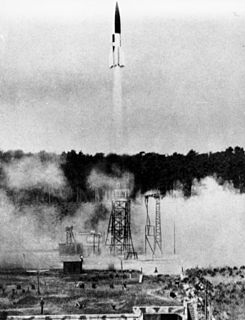
In modern language, a missile, also known as a guided missile or guided rocket, is a guided airborne ranged weapon capable of self-propelled flight usually by a jet engine or rocket motor. Missiles have four system components: targeting/guidance system, flight system, engine and warhead. Missiles come in types adapted for different purposes: surface-to-surface and air-to-surface missiles, surface-to-air missiles, air-to-air missiles, and anti-satellite weapons.
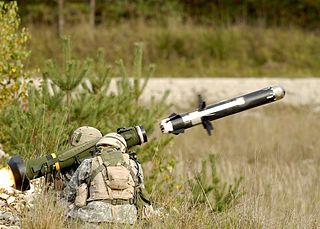
An anti-tank guided missile (ATGM), anti-tank missile, anti-tank guided weapon (ATGW) or anti-armor guided weapon is a guided missile primarily designed to hit and destroy heavily armored military vehicles.

Rapier is a surface-to-air missile developed for the British Army to replace their towed Bofors 40/L70 anti-aircraft guns. The system is unusual as it uses a manual optical guidance system, sending guidance commands to the missile in flight over a radio link. This results in a high level of accuracy, therefore a large warhead is not required.
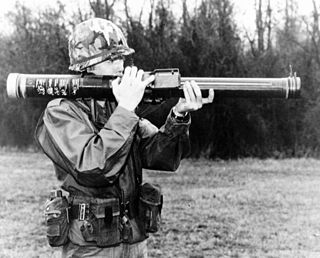
Anti-tank warfare originated from the need to develop technology and tactics to destroy tanks during World War I (1914–1918). Since the Triple Entente developed the first tanks in 1916 but did not deploy them in battle until 1917, the German Empire developed the first anti-tank weapons. The first developed anti-tank weapon was a scaled-up bolt-action rifle, the Mauser 1918 T-Gewehr, that fired a 13mm cartridge with a solid bullet that could penetrate the thin armor of tanks of the time and destroy the engine or ricochet inside, killing occupants. Because tanks represent an enemy's greatest force projection on land, military strategists have incorporated anti-tank warfare into the doctrine of nearly every combat service since. The most predominant anti-tank weapons at the start of World War II in 1939 included the tank-mounted gun, anti-tank guns and anti-tank grenades used by the infantry, as well as ground-attack aircraft.

The FGM-148 Javelin is an American man-portable fire-and-forget anti-tank missile fielded to replace the M47 Dragon anti-tank missile in US service. It uses automatic infrared guidance that allows the user to seek cover immediately after launch, as opposed to wire-guided systems, like the Dragon, which require the user to actively guide the weapon throughout the engagement. The Javelin's HEAT warhead is capable of defeating modern tanks by attacking them from above where their armor is thinnest, and is also useful against fortifications in a direct attack flight.
The multiple integrated laser engagement system, or MILES, is used by the U.S. military and other armed forces around the world for training purposes. It uses lasers and blank cartridges to simulate actual battle.

The MGM-166 LOSAT was a United States anti-tank missile system designed by Lockheed Martin to defeat tanks and other individual targets. Instead of using a High Explosive Anti-Tank warhead like other anti-tank missiles, the LOSAT employed a solid steel kinetic energy penetrator to punch through armor. The LOSAT is fairly light; it was designed to be mounted onto a Humvee while allowing the vehicle to remain air-portable. LOSAT eventually emerged on an extended-length heavy-duty Humvee with a hard-top containing four KEMs used by special operations. Although LOSAT never "officially" entered service, it was used for the smaller Compact Kinetic Energy Missile.

A fire-control system is a number of components working together, usually a gun data computer, a director, and radar, which is designed to assist a ranged weapon system in targeting, tracking and hitting its target. It performs the same task as a human gunner firing a weapon, but attempts to do so faster and more accurately.

The Panzerfaust 3 is a modern disposable recoilless anti-tank weapon, which was developed between 1978 and 1985 and put into service by the Bundeswehr in 1992. It was first ordered in 1973 to provide West German infantry with an effective weapon against contemporary Soviet armour, thereby replacing West Germany's aging PzF 44 Light Lanze launchers and the heavy Carl Gustaf 84 mm anti-tank recoilless rifle manufactured in Sweden. The Panzerfaust 3 is operated by at least 11 countries and has first seen combat in Afghanistan.

The HJ-8 or Hongjian-8 is a second generation tube-launched, optically tracked, wire-guided anti-tank missile system which was originally deployed by China's People's Liberation Army since the late 1980s.

A live-fire exercise or LFX is any military exercise in which a realistic scenario for the use of specific equipment is demonstrated. In the popular lexicon this is applied primarily to tests of weapons or weapon systems that are associated with the various branches of a nation's armed forces, although the term can be applied to the civilian arena as well.

The LAHAT is a third generation semi-active laser homing guided low-weight anti-tank guided missile developed since 1992 and manufactured by Israel Aerospace Industries. It was designed primarily to be fired by Merkava tanks' 105 mm and 120 mm tank guns, though it matches all types of 105 mm and 120 mm guns, including low recoil guns and low-weight guns of military armoured cars. It is also suitable for patrol ships, possibly modified for 105–106 mm recoilless rifles, UAVs, HMMWVs, and SPAAGs. Unlike other tank rounds, LAHAT does not need a tank gun for operation.
Weapon Effects Simulation (WES) is the creation of artificial weapons effects such as flashes, bangs and smoke during military training exercises. It is used in combination with Tactical engagement simulation (TES), which uses laser projection for training purposes instead of bullets and missiles. Typically, an accurate laser "shot" hitting a target such as a tank, will trigger cartridge-based WES equipment fitted to the tank which will give a flash, bang and smoke, signifying a hit in the exercise scenario.
List of abbreviations, acronyms and initials related to military subjects such as modern armour, artillery, infantry, and weapons, along with their definitions.

A precision-guided munition is a guided munition intended to precisely hit a specific target, to minimize collateral damage and increase lethality against intended targets. During the First Gulf War guided munitions accounted for only 9% of weapons fired, but accounted for 75% of all successful hits. Despite guided weapons generally being used on more difficult targets, they were still 35 times more likely to destroy their targets per weapon dropped.

A rocket is a self-propelled, unguided weapon system powered by a rocket motor. Rockets are used primarily as medium and long-range artillery systems, although historically they have also seen considerable use as air-to-surface, some use as air-to-air weapons, and even a few examples of surface-to-air devices. Examples of modern surface-to-surface rocket systems include the BM-27 Uragan and M270 Multiple Launch Rocket System.
Man-portable anti-tank systems are shoulder-launched anti-tank rockets. They are typically unguided weapons and are a threat to armored vehicles, low-flying aircraft, and field fortifications. Generally, MANPATS fall into three distinct categories. The first consist of a small, disposable preloaded launch tube firing a high explosive anti-tank warhead operated by a single soldier. The second is a firing system onto/into which a rocket is loaded, operated by a single soldier. The third are manufactured prepacked and issued as a single unit of ammunition with the launcher discarded after a single use.
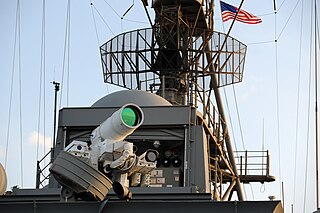
The AN/SEQ-3 Laser Weapon System or XN-1 LaWS is a laser weapon developed by the United States Navy. The weapon was installed on USS Ponce for field testing in 2014. In December 2014, the United States Navy reported that the LaWS system worked perfectly against low-end asymmetric threats, and that the commander of Ponce is authorized to use the system as a defensive weapon.
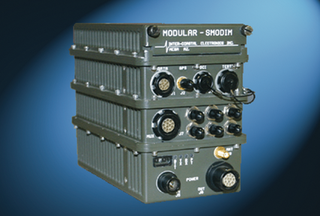
The Smart Onboard Data Interface Module (SMODIM) is used by the United States Army and foreign militaries for live simulated weapons training on military platforms. The SMODIM is the primary component of the Longbow Apache Tactical Engagement Simulation System that provides weapons systems training and collective Force-on-Force live training participation.
FAAC Incorporated is an American immersive simulation training company. They began as a military contractor, providing flight and weapons simulation systems to the U.S. Air Force, but have since branched out into transit and transportation simulation, law enforcement, Fire/EMS, research, and human-interaction simulation.













